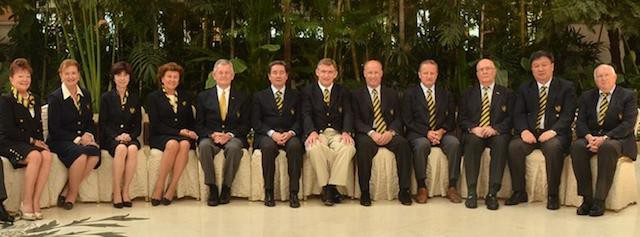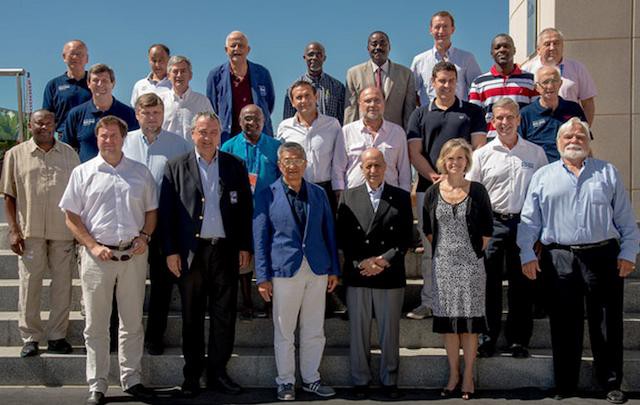Who Runs Olympic Sports? It's Men
by Michael Bertin
Congratulations field hockey, you’re the most progressive sport in the whole Olympic program.
That needs some clarification: It’s not the sports themselves under scrutiny here, but the sports’ governing bodies. The above graphic describes the gender makeup of the executive committees — the people in charge — of every sport in the Olympic program (London 2012 and Sochi 2014). That’s summer sports on top, winter on bottom; men on the right, women to the left.
For example, starting at the bottom — we are in the midst of the Sochi winter games, after all — the World Curling Federation has seven men and one woman on its executive committee (you can mouseover each horizontal bar for specifics).
Among all 33 bodies, field hockey’s executive committee comes closest to equality by percentage, topping out at 37.5% female. Holy heck, that’s pathetic. And even that fact comes with an asterisk. The last official document from the International Olympic Committee itself was a 2009 report in which the composition of the FIH executive board was listed as 17 men and six women. Currently, the official FIH website lists just the 16 members indicated by the above chart. That’s odd, because bureaucracies tend not to shrink.
Reverting to the IOC numbers would give the “most equal” title to skating, with four women holding one-third of the power. As an arbitrary threshold — 2:1 men to women — it should be an easily achievable minimum. But it’s almost the opposite, with only two governing bodies getting to that ratio. Oof. Collectively, it’s embarrassing. That chart is bluer than Karl Rove’s worst nightmare.
It’s even worse when you consider there is a credible argument to be made that women generate a disproportionate amount of horsepower in the economic engine that is the Olympics.

The single highest-rated night of programming from the 2012 London Olympics was Tuesday, July 31st, when NBC posted a 21.8 rating. That was the night they aired the womens’ team all-around finals in gymnastics. The second highest rated telecast from London happened two nights later, when the women’s individual all-around finals took place. Even if it wasn’t the most-watched night of the Olympics, it was still the largest audience to watch Thursday night TV on any network since the finale of “Friends” in 2004. Women also ruled online; NBC’s most-streamed event was the women’s soccer final.
Similarly, it’s a safe bet that the highest rated night of NBC’s coverage from Sochi will be one of the two nights of the ladies’ figure skating singles final. It was the highest-rated telecast in Vancouver, and Torino, and Salt Lake City. The women’s competition in Lillehammer is still the sixth highest rated TV program ever, with a 48.5. But it’s not every year you get hired goons whacking an ice princess on the knee.
Heck, the IOC added a new made-up figure skating event this year — the team competition — probably just to create more TV programming.

The International Skating Union council
It’s not only women athletes drawing viewers and it’s not only women being drawn to watch, but you don’t have to look too far beyond the commercials to infer that Y chromosomes aren’t being as pandered to by sponsors during the Olympics as they are during most sporting events. One commercial break over the opening weekend went: Cover Girl, Ameritrade, Disney, AT&T; and there was an ad for Secret — the exclusively female deodorant — in the previous break. That doesn’t sound overwhelmingly feminine, but the AT&T; commercial was basically emotional porn for being a mom. As well, GE and some paper towel made similar “Mom is Awesome” spots they are running throughout the games. More obviously, though, it’s not the beer-truck-truck-beer that usually dominates sports on TV. This isn’t new; the Times wrote about it back in Beijing.
And that is why NBC paid ridiculous money for the rights to the Olympics: $2B for the 2010 and 2012 games. The U.S. isn’t the only place that watches the Olympics; we just pay the most for the privilege. That $2B represents 51% of the total take for the IOC for that cycle. The next two biggest spenders combined — Europe and Japan — paid just over half of what NBC did.
So women are the biggest TV draws of the games, and they bring in casual female viewers who otherwise mightn’t watch primetime TV, much less sports. At least partially because of that, the most lucrative market fills the IOC’s TV coffers more than half-full by itself. Nice job, ladies.
But why are you so powerless off the ice or field or water or whatever then? Twelve of the 33 bodies have one or fewer women — that’d be zero for the mathematically challenged among you — on their executive committee.
Forget equality — getting to 50–50. There are only a couple of sports where the governing body is close to equity — here, mirroring the participating rates among genders at the games. Those are canoeing and boxing. The latter is partially because of a technicality. Women’s boxing just appeared on the Olympic program for the first time in London. The 36 female pugilists were dwarfed in volume by the 250 men. But, percentage-wise, the 12.6% of 2012 female boxing competitors lets the AIBA’s 10% female board look relatively equitable as a function of participation.
It’s probably a bad day in sports when the people running boxing can be held up as an example for others to follow.
Most everyone else is pretty lousy. And not to pile on any one federation, but FINA (the Fédération Internationale de Natation) is a particularly egregious offender. Because of synchronized swimming, there are actually more women than men under swimming’s purview at the Olympics (676 to 624, or 52% women). Yet, FINA has but one woman among 23 executive committee members. Mathematically, tennis and handball are slightly worse, but that’s because they have no female members at all (both are 50–50 in terms of athletes).

FINA’s “Bureau” at Barcelona in 2013. Photo by Giorgio Scala/Deepbluemedia.
Part of the problem is that these are independent organizations. They aren’t necessarily beholden to the IOC, or to anybody but themselves for that matter. For something like FIFA, soccer’s governing body (and it just added the first female member in 2012), the Olympics isn’t even the sport’s marquee event. It has much more important business, specifically running its own quadrennial graft-a-thon in the World Cup. Another part of the problem is that these are global organizations and there are plenty of parts of the world that still have Cro-Magnon views on gender roles.
That still leaves plenty to be explained. What the number of women on any given governing body ought to be is a separate argument. But if women are such an important part of the draw of the games (and hence its financial success), then it seems axiomatic that the numbers ought to be higher than what they currently are. The IOC could theoretically put pressure on these sports to put more women into positions of power. The games are expensive to stage and the IOC has already made moves to curb the number of competitors and limit costs. Baseball in 2008 was about 200 competitors for 3 medals. It’s one of the reasons it (and softball) got the kibosh after Beijing. Rowing has seen its events trimmed. Track and field has already been told its numbers will be capped for 2016.
It’d be two birds should the IOC threaten to remove competitor spots in sports if governing bodies don’t modernize their thinking (and numbers) with regard to women. It would be a laudable first step, and one that might actually be a catalyst for progress.
Of course the IOC might want to look inward first. With only four women among its 14 executive committee members, even it doesn’t reach that 2:1 threshold. And yet, apparently it could be worse.
Michael Bertin is a writer rarely in New York.
